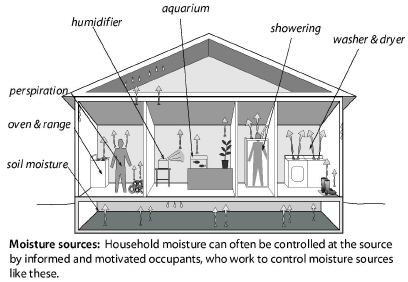
1.6 Reducing Moisture Problems
Moisture causes billions of dollars worth of property damage, sickness, and high energy bills each year in American homes. Water damages building materials by dissolving glues and mortar, corroding metal, and nurturing pests like mold, dust mites, and insects. These pests, in turn, cause respiratory illness.
Water reduces the thermal resistance of insulation and other building materials. High humidity also increases air-conditioning costs because the air conditioner removes moisture from the air to provide comfort.
The most common sources of moisture are leaky roofs and damp foundations. Other critical moisture sources include clothes dryers venting indoors, showers, cooking appliances, and unvented gas appliances like ranges or decorative fireplaces. Clients control many of these moisture sources, so educate them about how to reduce the moisture sources discussed here.
Climate is also a major contributor to moisture problems. The more rain, extreme temperatures, and humid weather a region experiences, the more of its homes are vulnerable to moisture problems.

Reducing moisture sources is the first priority for solving moisture problems. Next most important are air and vapor barriers to prevent water vapor from migrating through building cavities. Relatively tight homes need mechanical ventilation to remove accumulating water vapor.
1.6.1 Moisture Sources and Effects
Water or material wetting due to high relative humidity reduces the thermal resistance of insulation and other building materials. High humidity also increases air-conditioning costs because the air conditioner must remove airborne moisture to provide comfort.
The most common sources of moisture are leaky roofs and damp foundations. Other critical moisture sources include clothes dryers venting indoors, long showers, cooking, and unvented gas appliances like ranges or decorative fireplaces. Clients control many of these moisture sources, so educate them about how to reduce moisture sources.
Climate is also a major contributor to moisture problems. The more rain, extreme temperatures, and humid weather a region experiences, the more its buildings are vulnerable to moisture problems.
|
Moisture Source |
Potential Amount Pints |
|---|---|
|
Ground moisture |
0–105 per day |
|
Unvented combustion space heater |
0.5–20 per hour |
|
Seasonal evaporation from materials |
6–19 per day |
|
Dryers venting indoors |
4–6 per load |
|
Dish washing |
1–2 per day |
|
Cooking (meals for four persons) |
2–4 per day |
|
Showering |
0.5 per shower |
1.6.2 Moisture Reduction Priorities
Follow these priorities by number to reduce moisture problems.
1. Reduce moisture sources such a roof leaks, plumbing leaks, and standing water around the building’s perimeter outdoors.
2. Install air and vapor barriers to prevent water vapor from migrating out of the soil and into building materials and building cavities.
3. Provide mechanical ventilation to remove accumulated water vapor. See Ventilation.

1.6.3 Symptoms of Moisture Problems
Condensation on windows, walls, and other cool surfaces signals high relative humidity and the need to reduce moisture sources.
During very cold weather or summer air conditioning, condensation may occur on cold surfaces. Occasional condensation isn’t a major problem. However, if condensation happens frequently, take action to reduce moisture sources. Adding insulation helps eliminate cold walls, ceilings, and air-conditioning ducts where water vapor condenses.
Moisture problems arise when parts of the building become wet often and remain wet. Moisture in organic or porous building materials reaches a threshold that allows pests like mold, dust mites, and insects to thrive. These pests can cause or trigger asthma, bronchitis, and other respiratory ailments because they produce potent biological allergens.
Rot and wood decay indicate advanced moisture damage. Unlike surface mold and mildew, wood decay fungi and insects penetrate, soften, and destroy wood.
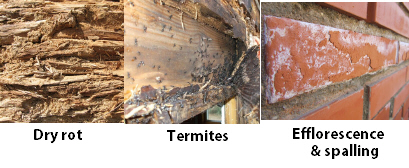
Peeling, blistering, or cracking paint may indicate that moisture is moving through a building material or assembly, damaging the paint and the materials underneath.
Corrosion, oxidation, and rust on metal are unmistakable signs of moisture problems. Deformed wooden surfaces may appear as the damp wood swells, and later warps and cracks as it dries.
Efflorescence is a white, powdery deposit left by water that moves through masonry and leaves minerals behind as it evaporates from the masonry surface. Masonry materials experience spalling with efflorescence that deteriorates their surfaces.
1.6.4 Solutions for Moisture Problems
Preventing moisture problems is the best way to guarantee a building’s durability and its occupant’s respiratory health. However, the solutions get progressively more expensive if simple solutions don’t solve the problems.
Inexpensive Moisture Solutions
If moisture source reduction isn’t adequate to prevent moisture problems, try these solutions after preventive measures are in place.
✓ Install a ground moisture barrier. See Crawl Space Moisture and Safety Issues.
✓ Verify that clothes dryers and exhaust fans vent to the outdoors and not into crawl spaces or attics.
✓ Seal water leaks in the foundation.
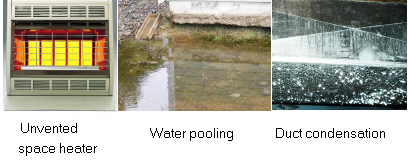
✓ Seal water leaks in the roof.
✓ Remove unvented space heaters, a major source of moisture, from the dwelling.
✓ Educate clients about ways to reduce moisture that they control.
✓ Educate customers to avoid excessive watering around the building’s perimeter. Watering lawns and plants close to the building can dampen its foundation. In moist climates, cut shrubbery back away from the foundation, allowing air to circulate near the foundation.
✓ Insulate air-conditioning ducts to prevent summer condensation.
More Costly Moisture Solutions
Follow these preventive measures before trying any of the solutions in the next section.
✓ Install or improve air barriers and vapor barriers to prevent air leakage and vapor diffusion from transporting moisture into building cavities. See Shell Air-Leakage Fundamentals.
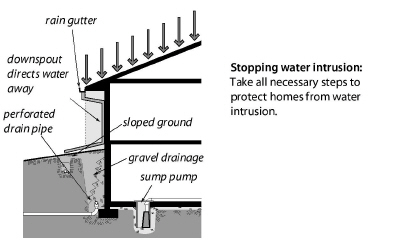
✓ Add insulation to the walls, floor, and ceiling of a building to keep the indoor surfaces warmer and less prone to winter condensation. During cold weather, well-insulated homes can tolerate higher humidity without condensation than can poorly insulated homes.
✓ A sump pump is the most effective remedy when ground water continually seeps into a basement or crawl space and collects there as standing water. Persistent ground-water seepage may only be solved by connecting an interior perimeter drain to the sump. The sump cover must not interfere with drainage and must be accessible and rigid. See "Sump pump" on page 43.
✓ Ventilate the dwelling with drier outdoor air to dilute the more humid indoor air. Ventilation is only effective when the outdoor air is drier than the inside air, such as in winter. In summer, outdoor air may be more or less humid than indoor air depending on climate, time of day, and whether the dwelling is air conditioned. See Air Leakage Diagnostics.

Dehumidifiers and Air-Conditioners for Drying
As a last resort, remove moisture from indoor air by cooling the air to below its dew point with dehumidifiers in winter and air-conditioners in summer. Using air conditioners and dehumidifiers for drying a building is the most expensive solution. Try all the moisture solutions discussed previously before resorting to a dehumidifier.
The dehumidifier should meet these specifications.
✓ Must be Energy Star or more efficient.
✓ Must have a fan-off option.
✓ Must retain automatic settings after power interruption.
✓ Must be rated for low temperature operation if located in a basement or crawl space.
When you install a dehumidifier, observe these requirements.
✓ Install the dehumidifier in a location that allows free airflow around it.
✓ The dehumidifier should have automatic controls to limit energy and power.
✓ Make sure that the dehumidifier works and measure the relative humidity in the space before completing the installation.
✓ Drain the dehumidifier’s collected water to a plumbing drain in a code-approved way.
✓ Give the homeowner the user guide and warranty information, and explain how to use the dehumidifier. Show the occupant how to clean or change the filter and how to clean the condensate drain.
1.6.5 Crawl Space Moisture and Safety Issues
Air, water vapor, liquid water, and pollutants move through soil and into crawl spaces and dirt-floor basements. Even if soil’s surface seems dry and airtight, the soil may allow a lot of water vapor and soil gases to enter a home.
Cover the ground with an airtight moisture barrier to prevent the movement of moisture and soil gases from the ground into the crawl space using these procedures.
✓ The crawl space should have an access hatch or door that is sized adequately for a worker or a resident to enter and exit.
✓ Remove biodegradable matter, such as wood and cardboard, from the crawl space.
✓ Cover the ground completely with a ground moisture barrier such as 6-mil polyethylene where little or no foot traffic exists. Install reinforced or cross-linked polyethylene where the barrier will see foot traffic, such as when the crawl space is used for storage.
✓ The edges of the barrier should run at least 6” up the foundation walls and internal supporting structures. Fasten the barrier with wood strips, masonry fasteners, and sealant. Installers may also adhere the barrier with polyurethane adhesive or acoustical sealant to a clean and flat masonry surface.
✓ Seal the edges and seams with urethane, acoustical sealant, butyl caulking, or construction tape to create an airtight seal between the crawl space and the ground underneath. Seams must overlap 12 inches.
✓ To avoid trapping of moisture against wood surfaces, ground moisture barriers must not touch wood structural members, such as posts, mud sills, or floor joists.
✓ Post a sign on the crawl-space accesses to caution those who enter not to damage insulation, ground barrier, or mechanical systems. Also caution entrants not to store hazardous materials in the crawl space.
1.6.6 Ground Moisture Source-Reduction
Observe the following specifications to avoid building deterioration from ground moisture, in accordance with the allowable measures chart. Finish the following tasks before air sealing the floor or installing underfloor insulation, with non-DOE funds or as allowed under DOE guidelines.
✓ Repair plumbing or sewer leaks.
✓ Solve all drainage problems, ground-water problems, wood-deterioration, and structural problems.
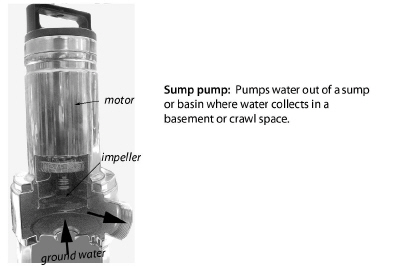
✓ Verify that the ground outside the home slopes away from the foundation or that water doesn’t puddle near the foundation.
✓ Install or repair rain gutters as necessary, and verify that downspouts discharge rainwater at least 3 feet away from the home.
✓ Verify that all combustion vents (chimneys), clothes-dryer vents, and exhaust fan vents are vented to outdoors and not into crawl spaces.
✓ Suggest a sump pump for crawl spaces or basements with a history of flooding. The sump pump should be located in an area where it collects water from the entire below-grade area and pumps it away from the foundation to daylight.
✓ Provide crawl-space ventilation which follows the requirements of the IRC and SWS. See Crawl Space Ventilation.